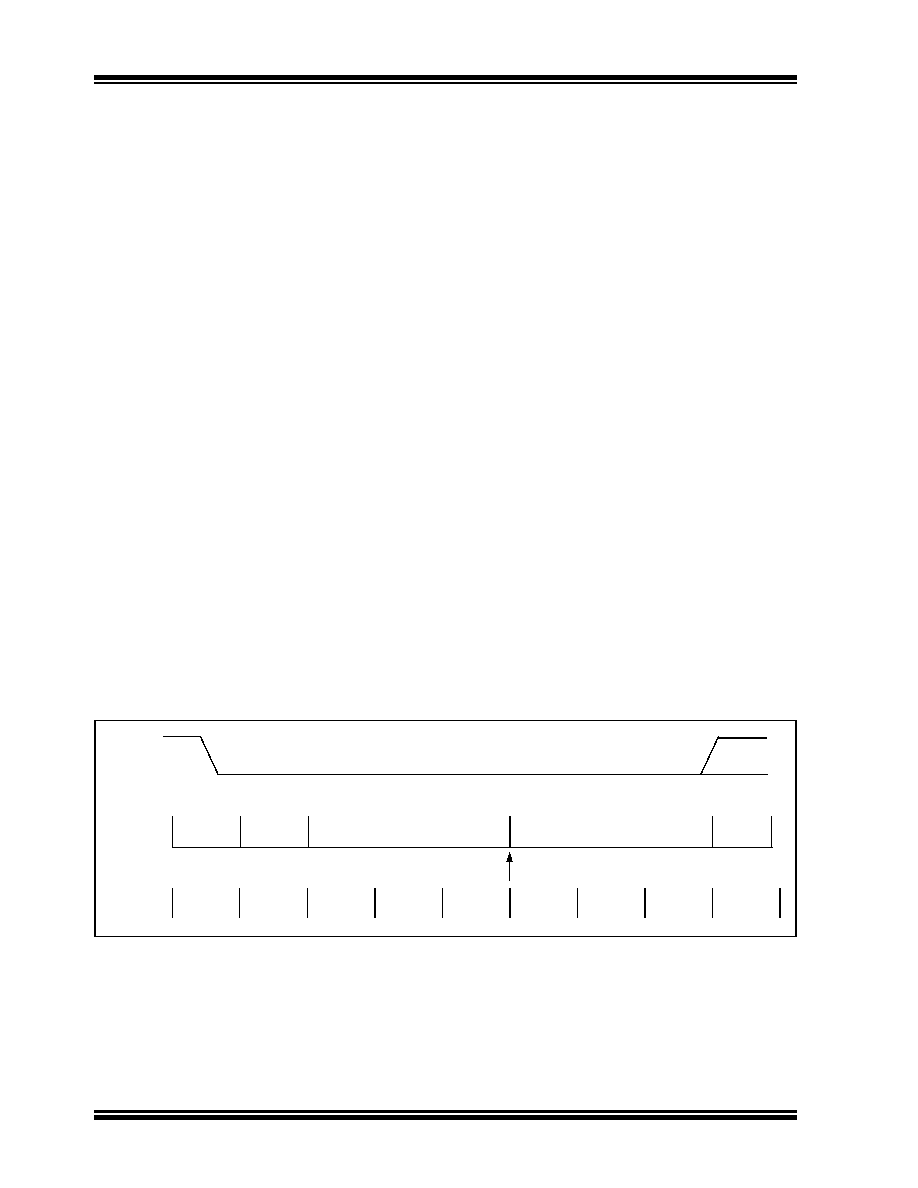- 您现在的位置:买卖IC网 > Sheet目录1917 > DSPIC30F4011-30I/ML (Microchip Technology)IC DSPIC MCU/DSP 48K 44QFN

dsPIC30F4011/4012
DS70135G-page 134
2010 Microchip Technology Inc.
19.5.6
TRANSMIT INTERRUPTS
Transmit interrupts can be divided into 2 major groups,
each including various conditions that generate
interrupts:
Transmit Interrupt
At least one of the three transmit buffers is empty (not
scheduled) and can be loaded to schedule a message
for transmission. Reading the TXxIF flags will indicate
which transmit buffer is available and caused the
interrupt.
Transmit Error Interrupts
A transmission error interrupt will be indicated by the
ERRIF flag. This flag shows that an error condition
occurred. The source of the error can be determined by
checking the error flags in the CAN Interrupt Status reg-
ister, C1INTF. The flags in this register are related to
receive and transmit errors.
Transmitter warning interrupt.
The TXWAR bit indicates that the Transmit Error
Counter has reached the CPU warning limit of 96.
Transmitter error passive.
The TXEP bit (C1INTF<12>) indicates that the
Transmit Error Counter has exceeded the error
passive limit of 127 and the module has gone to
error passive state.
Bus off.
The TXBO bit (C1INTF<13>) indicates that the
Transmit Error Counter (TERRCNT<7:0>) has
exceeded 255 and the module has gone to bus off
state.
19.6
Baud Rate Setting
All nodes on any particular CAN bus must have the
same nominal bit rate. In order to set the baud rate, the
following parameters have to be initialized:
Synchronization Jump Width
Baud Rate Prescaler
Phase Segments
Length Determination of Phase2 Seg
Sample Point
Propagation Segment Bits
19.6.1
BIT TIMING
All controllers on the CAN bus must have the same
baud rate and bit length. However, different controllers
are not required to have the same master oscillator
clock. At different clock frequencies of the individual
controllers, the baud rate has to be adjusted by
adjusting the number of time quanta in each segment.
The nominal bit time can be thought of as being divided
into separate non-overlapping time segments. These
segments are shown in Figure 19-2.
Synchronization segment (Sync Seg)
Propagation time segment (Prop Seg)
Phase segment 1 (Phase1 Seg)
Phase segment 2 (Phase2 Seg)
The time segments and also the nominal bit time are
made up of integer units of time called time quanta or
TQ. By definition, the nominal bit time has a minimum
of 8 TQ and a maximum of 25 TQ. Also, by definition,
the minimum nominal bit time is 1
μsec, corresponding
to a maximum bit rate of 1 MHz.
FIGURE 19-2:
CAN BIT TIMING
Input Signal
Sync
Prop
Segment
Phase
Segment 1
Phase
Segment 2
Sync
Sample Point
TQ
发布紧急采购,3分钟左右您将得到回复。
相关PDF资料
DSPIC30F4013-30I/ML
IC DSPIC MCU/DSP 48K 44QFN
DSPIC30F5013-30I/PT
IC DSPIC MCU/DSP 66K 80TQFP
DSPIC30F5015-30I/PT
IC DSPIC MCU/DSP 66K 64TQFP
DSPIC30F6010-20E/PF
IC DSPIC MCU/DSP 144K 80TQFP
DSPIC30F6010A-30I/PF
IC DSPIC MCU/DSP 144K 80TQFP
DSPIC30F6013A-30I/PF
IC DSPIC MCU/DSP 132K 80TQFP
DSPIC30F6014-30I/PF
IC DSPIC MCU/DSP 144K 80TQFP
DSPIC33EP512MU814-I/PL
IC DSC 16BIT 512KB 144LQFP
相关代理商/技术参数
DSPIC30F4011-30I/P
功能描述:数字信号处理器和控制器 - DSP, DSC 16bit Signal Cntrlr RoHS:否 制造商:Microchip Technology 核心:dsPIC 数据总线宽度:16 bit 程序存储器大小:16 KB 数据 RAM 大小:2 KB 最大时钟频率:40 MHz 可编程输入/输出端数量:35 定时器数量:3 设备每秒兆指令数:50 MIPs 工作电源电压:3.3 V 最大工作温度:+ 85 C 封装 / 箱体:TQFP-44 安装风格:SMD/SMT
DSPIC30F4011-30I/PT
功能描述:数字信号处理器和控制器 - DSP, DSC 16 Bit MCU/DSP 30M 48KB FL RoHS:否 制造商:Microchip Technology 核心:dsPIC 数据总线宽度:16 bit 程序存储器大小:16 KB 数据 RAM 大小:2 KB 最大时钟频率:40 MHz 可编程输入/输出端数量:35 定时器数量:3 设备每秒兆指令数:50 MIPs 工作电源电压:3.3 V 最大工作温度:+ 85 C 封装 / 箱体:TQFP-44 安装风格:SMD/SMT
DSPIC30F4011T-20E/ML
功能描述:数字信号处理器和控制器 - DSP, DSC 16 Bit MCU/DSP 44LD 20M 48KB FL RoHS:否 制造商:Microchip Technology 核心:dsPIC 数据总线宽度:16 bit 程序存储器大小:16 KB 数据 RAM 大小:2 KB 最大时钟频率:40 MHz 可编程输入/输出端数量:35 定时器数量:3 设备每秒兆指令数:50 MIPs 工作电源电压:3.3 V 最大工作温度:+ 85 C 封装 / 箱体:TQFP-44 安装风格:SMD/SMT
DSPIC30F4011T-20E/PT
功能描述:数字信号处理器和控制器 - DSP, DSC 16 Bit MCU/DSP 20M 48KB FL RoHS:否 制造商:Microchip Technology 核心:dsPIC 数据总线宽度:16 bit 程序存储器大小:16 KB 数据 RAM 大小:2 KB 最大时钟频率:40 MHz 可编程输入/输出端数量:35 定时器数量:3 设备每秒兆指令数:50 MIPs 工作电源电压:3.3 V 最大工作温度:+ 85 C 封装 / 箱体:TQFP-44 安装风格:SMD/SMT
DSPIC30F4011T-20I/ML
功能描述:数字信号处理器和控制器 - DSP, DSC DIG SIG CONTR RoHS:否 制造商:Microchip Technology 核心:dsPIC 数据总线宽度:16 bit 程序存储器大小:16 KB 数据 RAM 大小:2 KB 最大时钟频率:40 MHz 可编程输入/输出端数量:35 定时器数量:3 设备每秒兆指令数:50 MIPs 工作电源电压:3.3 V 最大工作温度:+ 85 C 封装 / 箱体:TQFP-44 安装风格:SMD/SMT
DSPIC30F4011T-20I/PT
功能描述:数字信号处理器和控制器 - DSP, DSC 16 Bit MCU/DSP 20M 48KB FL RoHS:否 制造商:Microchip Technology 核心:dsPIC 数据总线宽度:16 bit 程序存储器大小:16 KB 数据 RAM 大小:2 KB 最大时钟频率:40 MHz 可编程输入/输出端数量:35 定时器数量:3 设备每秒兆指令数:50 MIPs 工作电源电压:3.3 V 最大工作温度:+ 85 C 封装 / 箱体:TQFP-44 安装风格:SMD/SMT
DSPIC30F4011T-30I/ML
功能描述:数字信号处理器和控制器 - DSP, DSC 16 Bit MCU/DSP 44LD 30M 48KB FL RoHS:否 制造商:Microchip Technology 核心:dsPIC 数据总线宽度:16 bit 程序存储器大小:16 KB 数据 RAM 大小:2 KB 最大时钟频率:40 MHz 可编程输入/输出端数量:35 定时器数量:3 设备每秒兆指令数:50 MIPs 工作电源电压:3.3 V 最大工作温度:+ 85 C 封装 / 箱体:TQFP-44 安装风格:SMD/SMT
DSPIC30F4011T-30I/PT
功能描述:数字信号处理器和控制器 - DSP, DSC 16 Bit MCU/DSP 30M 48KB FL RoHS:否 制造商:Microchip Technology 核心:dsPIC 数据总线宽度:16 bit 程序存储器大小:16 KB 数据 RAM 大小:2 KB 最大时钟频率:40 MHz 可编程输入/输出端数量:35 定时器数量:3 设备每秒兆指令数:50 MIPs 工作电源电压:3.3 V 最大工作温度:+ 85 C 封装 / 箱体:TQFP-44 安装风格:SMD/SMT